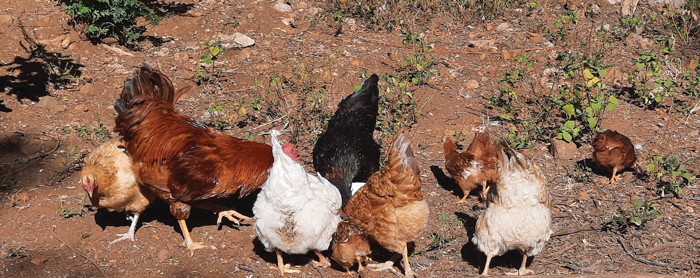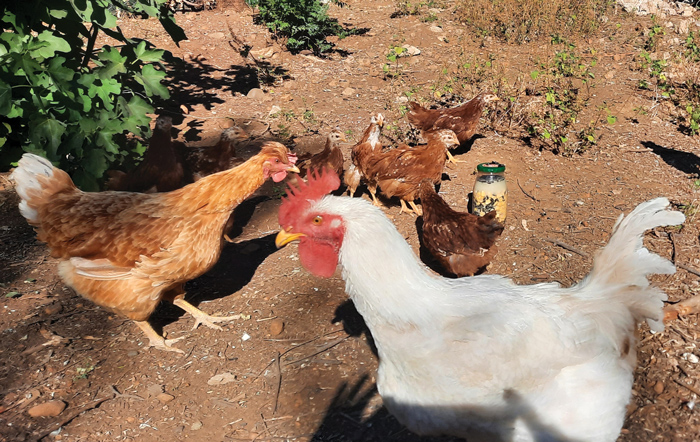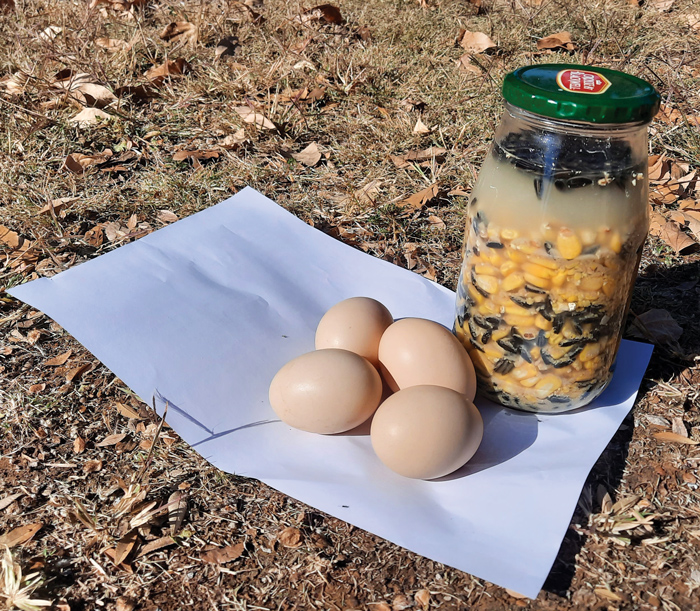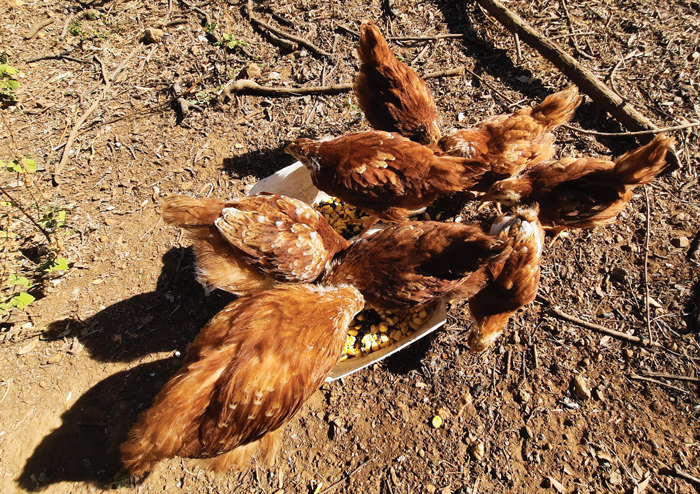
When I grew up, I used to see chickens run like crazy when they hear the scraping sound coming from the cleaning of soaked pots that contained cooked pap the previous day. When we wanted to catch a chicken, we would sometimes pretend to be scraping a pot just to get them to gather around. I used to think that the chickens were just hungry and rushing for food. However, this meal was fermented food, which the chickens probably knew a lot more about than the young me.

Fermentation process
Fermentation is nothing new. People have been using this process as a method of food preservation for hundreds of years. Foods such as sourdough bread, buttermilk, cheese, pickles, kimchi, apple-cider vinegar, beer and wine take advantage of fermentation. Fermenting your chicken feed is a great way to ensure you are feeding your chickens some of the healthiest food possible, plus it will also save some money from your feed bill. The latter will become clear in the discussion below.

HOW TO FERMENT CHICKEN FEED
- Start by fermenting about 66% (two thirds) of what you have already been feeding your birds on a daily basis. Fill the container about one third with the feed mixture. Pour in enough non-chlorinated water so that the solids are completely submerged by about 5 cm, leaving some room in the jar/bucket to allow for expansion. City tap water contains chlorine and other additives that are meant to kill bacteria. This would be bad news for the healthy bacteria needed to start the lacto-fermentation process in your feed.
- Avoid using metal containers, as the high acid content of fermented feed can sometimes interact with the metals and cause contamination of the feed.
- Cover your container with a piece of cloth or a lid that has holes to allow for air to flow. Put the container in a cool location, out of direct sunlight.
- Stir a few times a day for three days, adding more water when necessary, to keep the grains submerged. The first day of soaking greatly improves the digestibility by reducing the phytic acid and enzyme inhibitors found in all grains, seeds and legumes. By the second day, lactic-acid bacteria begin the process of fermentation by consuming the sugars in the grains and producing lactic acid. The lactic acid, in turn, makes the environment unsuitable for bad bacteria, leaving behind only beneficial microbes.
- After two days, you should start to see some milky liquid and bubbles forming. The mixture should smell a bit tangy, like sourdough. After three days, you can strain the water from what you need to feed the chickens. Only feed your chickens what they will eat at one sitting to prevent the feed from getting mouldy and to maximise the nutritional value. Remember to always keep at least 5 cm of water covering the feed to help protect it from harmful bacteria growth.
- After you have scooped out all the solids from your batch, you can reuse the liquid by adding more feed and grains to start another batch. Subsequent batches will ferment even faster this way, as there is already a build-up of good bacteria that has to carry out the fermentation process. If your liquid starts to smell rancid or gets really thick and cloudy, you can throw it away and start all over again.

Food that can be fermented
Virtually anything you would normally feed to chickens can be fermented, but research shows that it is more beneficial to ferment grains. Fermentation makes grains more digestible and birds then get more nutrients from it. The process also helps to create new vitamins which are not normally present in the feed in a high quantity, including vitamin K and some of the B vitamins. It also breaks down unpalatable husks such as those on barley, which normally prevents the bird from gaining maximum nutrition because the gizzard can’t break it down.
Here are some of the feeds that can be used, but it is not limited to this list only:
- Commercial poultry feed (pellets or mash).
- Whole grains including wheat, maize, barley and oats.
- Sunflower and pumpkin seeds.
- Flours or grains from the pantry that have expired, such as old rice and seeds.
- Chopped lucerne.
- Vegetables (not onions) and fruit.
Benefits
Feeding fermented feed to poultry daily is an excellent way to provide a natural probiotic option to your flock. Unlike natural options, a synthetic probiotic should not be offered daily.
By providing fermented feed to chickens and other poultry, the following healthy things can happen:
- Increase in egg weight and shells will be harder due to better absorption of minerals.
- Providing and preserving vitamins and minerals found in fermented whole grains – B vitamins such as folic acid, riboflavin, thiamine and niacin.
- Proteins in grains are often hard to break down and use in the body, but soaking allows better use of proteins.
- Boost in intestinal health, forming a natural barrier to pathogens such as E. coli and Salmonella. The hens will also be far less likely to be fatally hurt by diseases and pests carried by the local wild birds.
- It increases beneficial bacteria in their gut and decreases pathogens in the hens’ digestive systems.
- It improves the digestibility of feed and nutrient absorption. Chickens find it easier to digest fermented feed and absorb it more effectively.
- Improved digestibility leads to lower feed consumption.
- Increases water intake, as water is consumed with the feed.
Summary
Because the nutrients are more readily absorbed in fermented foods, feed requirements lessen. There is also less waste, as the chickens love it. This contributes to saving money, as less feed will be needed. With a lower intake of feed there will be less droppings, which is reducing the time necessary to clean the chicken coops.
As a wide variety of food stuff can be fermented, there is no reason why those who enjoy a sizable piece of land cannot keep chicken and have fresh eggs and meat when needed at a very low cost. When you change from dry feed to fermented feed, allow for some time for your chickens to get used to the new feed.
It is very important to keep in mind that adding water to your dry chicken feed will also reduce its shelf life. When fermenting your feed, ensure that each batch you ferment will be consumed within three to four days before it rots.
References
- Heres L, Engel B, Van Knapen F, De Jong MCM, Wagenaar JA and Urlings HAP, 2003. Fermented liquid feed reduces susceptibility of broilers for Salmonella enteritidis. Poultry Science. 82:603 – 611
- Naji SA, Al-Zamili IFB, Jawad HSA and Al-Gharawi JKM, 2016. The effects of fermented feed on broiler production and intestinal morphology. Tropical agricultural science. 39 (4): 597 – 607
- Sugiharto S and Ranjitkar S, 2009. Recent advances in fermented feeds towards improved broiler chicken performance, gastrointestinal tract microecology and immune responses: A review. Animal Nutrition. 5:1 – 10
- https://smallpetselect.com/pros-and-cons-of-fermenting-chicken-feed
- https://thisbeautifulfarmlife.com/fermented-chicken-feed/
- https://www.bestfarmingtips.com/poultry
- https://www.fresheggsdaily.blog/2015/03/how-to-save-money-fermenting.html









